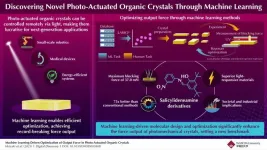(Press-News.org) Mill Valley, CA – April 15, 2025 – SynGAP Research Fund (SRF), dba Cure SYNGAP1, the leading patient advocacy group dedicated to improving the lives of those affected by SYNGAP1-related disorders (SRD), today announced the appointment of Jaime Aranda, Steve Gore, Heather Mestemaker, and Brian Smith to its Board of Trustees, effective April 15, 2025. They will succeed outgoing Trustees Emily Barnes, Sydney Stelmaszek, and Stella Tavilla, whose terms conclude on April 14, 2025. Additionally, a seat previously held by Pavel Gerovich, who stepped down in June 2024 for employment-related reasons, will also be filled.
“We are fortunate to have a dedicated team providing governance, strategic oversight, and fiduciary leadership to advance SRF’s mission in the SYNGAP1 rare disease space. As SYNGAP1 family members, our Trustees bring a deep, personal understanding of our desire to support the SYNGAP1 community, drive the development of therapies, and establish clinical sites in an effort to enhance the SYNGAP1 quality of life and, ultimately, cure SYNGAP1-related disorders,” states Suzanne Jones, MBA, SRF’s Board of Trustees Chairperson.
The SRF community warmly welcomes the newest members of its Board of Trustees, who bring a wealth of talent to our patient advocacy group. We also extend our heartfelt gratitude to our outgoing Trustees for their devoted service and invaluable contributions to SRF.
Incoming Trustees:
About Jaime Aranda
An accomplished corporate governance professional with extensive project management experience, most recently at Partners Group and Freshfields Bruckhaus Deringer, Mr. Aranda stepped away from his career during COVID to care for his children. He later served on the Hilltop Children’s Center Board for several years and has remained active in real estate investment. This diverse background equips him well for his role as a Trustee. Following his son’s SYNGAP1 diagnosis in late 2024, Mr. Aranda quickly became engaged with SRF, attending the 2024 SYNGAP1 Conference in LA and advocating on Capitol Hill for Rare Disease Week with other SYNGAP1 parents. A native of Spain and current resident of suburban Chicago, Mr. Aranda holds an undergraduate degree from University of Seville (Spain), a secondary degree from London Metropolitan University (United Kingdom), and a graduate degree from BPP University Law School in London (United Kingdom).
About Steve Gore
Steve Gore’s expansive senior executive experience and board leadership make him a valuable addition to SRF’s Board of Trustees. With a distinguished career spanning over a decade in leadership at Gerber Scientific, followed by several years as Chief Operating Officer at Momentum Manufacturing Group, he now serves as President and CEO of Alinabal Group. Mr. Gore has also held various board positions, including serving as Chair of the Concord Christian Academy Board and as a board member for the Monarch School of New England. After years of medical consultations, his daughter was finally diagnosed with SYNGAP1 at age 10 in 2016. Now that she is an adult, Mr. Gore is committed to apply his strategic leadership expertise to advance SRF’s mission to cure SYNGAP1. A longtime New Hampshire resident, Mr. Gore holds a BS in Business Management from New Hampshire College and an MBA from Southern New Hampshire University.
About Heather Mestemaker
Having previously consulted with SRF on high-level strategic planning, represented SRF at conferences and events in her local Philadelphia area, and presented on Cell and Gene Therapy at a BIOTECHx conference, Heather Mestemaker is already deeply engaged with SRF. With a strong background in marketing leadership within the biopharmaceutical industry—primarily at GSK and Merck—Mrs. Mestemaker is currently an independent consultant. She most recently served as Vice President, Medicine Commercialization Lead at GSK for a rare liver drug. Her biopharma expertise spans marketing, commercial launch strategy and operations, analytics, and sales. Additionally, she has consulted in marketing, strategy, and healthcare in general. Having a son with SYNGAP1 has fueled her passion for advancing rare disease drug and treatment discovery. Mrs. Mestemaker holds a BA in Psychobiology from Yale University and MBA from The Wharton School of Business, University of Pennsylvania.
About Brian Smith
Brian Smith brings a wealth of expertise to SRF’s Board of Trustees, further diversifying the backgrounds represented with his vast engineering experience. Currently Vice President of Engineering and Logistics Services at Dollar Tree Stores, Inc., Mr. Smith has held various engineering leadership roles at Amazon and spent more than a decade at Dematic Corporation. Residing in Virginia Beach, Virginia with his family, Mr. Smith felt called to join SRF after his youngest child was recently diagnosed with SYNGAP1. His commitment to SRF reflects the dedication of families working tirelessly to support and advocate for children affected by the disorder. Mr. Smith holds a BS in Mechanical Engineering from Kettering University and an MBA with a Finance focus from Grand Valley State University.
Outgoing Trustees:
About Emily Barnes
Emily Barnes of Danvers, MA served on SRF’s Board of Trustees’ executive team as Secretary for the past two years, playing an instrumental role in the organization’s oversight. She is stepping down to focus on her family, including her daughter, who was diagnosed with SYNGAP1 in 2022. Mrs. Barnes holds a BS from University of Arizona and has built a longstanding career in the telecom industry, where she gained valuable experience in project management, relationship building, and strategic analytics. While she is transitioning off the Board, her passion for advocacy and commitment to the SYNGAP1 community will remain steadfast, as will her dedication to supporting SRF initiatives.
About Pavel Gerovich
Currently residing in suburban New York City, Pavel Gerovich has built a distinguished career in the financial sector, spanning several years and multiple continents. Armed with a BS in Finance from Bentley University in Massachusetts, he has applied his expertise building financial services software. As the father of a child with SYNGAP1, Mr. Gerovich has been deeply involved with SRF, contributing as both a Trustee and a key figure in grants management. He has also made a lasting impact as a former Chairman of SRF’s Board of Trustees, bringing thoughtful and insightful leadership to advance the patient advocacy group’s mission and support groundbreaking research.
About Sydney Stelmaszek
A pivotal SRF volunteer, Sydney Stelmaszek resides in Pittsburgh, PA. Having just welcomed her fourth son, Mrs. Stelmaszek is balancing motherhood—including caring for a son with SYNGAP1—with her career and ongoing advocacy. The Stelmaszeks have hosted large-scale fundraisers for SRF over the years, including Cannonball for the Cure and the 2024 UFD Charity Stream, a six-day, 21-hour livestream fundraiser. (The timing corresponds with the genetic address for SYNGAP1, 6.21, as the SYNGAP1 gene is located on the 6th chromosome at the 21st locus.) A graduate of University of Florida with a degree in zoology, Mrs. Stelmaszek has dedicated her career to nonprofit work, including a long-standing role with Life Child Africa Foundation.
About Stella Tavilla
With an impressive background in corporate management and consulting—including her tenure as CIO for Home Shopping Network—Stella Tavilla has been a dedicated and influential member of SRF’s Board. Her previous board experience has greatly enhanced her leadership at SRF and contributed to her impactful governance expertise. Ms. Tavilla and her sisters have united in support of their brother, whose daughter was diagnosed with SYNGAP1 in 2019. The Tavilla family has been a major contributor to SRF and is known for championing a top-performing Sprint4Syngap fundraising team. Now retired, Ms. Tavilla resides in coastal North Carolina where she remains active in the local SYNGAP1 community.
SRF Board of Trustees Responsibilities
SRF Trustees are its key decision makers who address the organization’s mission, strategy, and goals. The Board’s governance covers the oversight for the organization, large-scale planning, and overall direction of the non-profit. The role of a Board generally includes legal and fiduciary responsibilities, Board meeting attendance, executive compensation decisions, and committee service. Committed to excellence, our Board members are volunteers and SYNGAP1 relatives who serve a minimum of two years, with key executive roles held by the President, Secretary, and Treasurer. Since its inception, there have been 32 different members on the Board. This has brought unique perspectives from our community while also enabling SRF to engage diverse, experienced individuals who represent all of our families.
About SYNGAP1-Related Disorders (SRD)
SYNGAP1-related disorders (ICD-10 F78.A1) are a rare genetic disorder caused by variants on the SYNGAP1 gene that reduce SYNGAP1 protein levels. SRF has identified over 1,581 patients to date, and the number grows weekly. This protein acts as a regulator in the synapses (where neurons communicate with each other). When SYNGAP1 protein levels are too low, we see an increase in excitability in the synapses making it difficult for neurons to communicate effectively. This leads to many neurological issues seen in SYNGAP1 patients.
Symptoms of SRD include primarily neurological issues including autism spectrum disorder (ASD), intellectual disability, epilepsy, hypotonia (low muscle tone), gross and fine motor delays, global developmental delay, and visual abnormalities such as strabismus (crossed eyes) as well as gastrointestinal challenges and disordered sleep.
About the SynGAP Research Fund
The mission of the SynGAP Research Fund (SRF) dba Cure SYNGAP1 is to improve the quality of life for SYNGAP1 patients through the research and development of treatments, therapies, and support systems.
SRF was founded in the US in 2018 as a 501(c)(3) US public charity. There are sister organizations founded by local families in the UK in 2020, Europe (Netherlands) in 2022, as well as both Australia & Latin America (Colombia) in 2023. Completely family-led, SRF is a leading funder of SYNGAP1 research having committed over $6.2 million in grants to date.
SRF’s grant program awards one or two-year grants to investigators, physician residents, and clinicians interested in studying SYNGAP1. SRF grants are intended to help researchers explore novel ideas and answer open questions related to the clinical aspects of and therapies for SRD. You can learn more about SRF and their accomplishments by reading their current Impact Report.
For more on SRF, visit curesyngap1.org or follow @cureSYNGAP1 on LinkedIn, YouTube, Instagram, Facebook, TikTok, or X.
SRF is a member of FasterCures, COMBINEDBrain, Global Genes Foundation Alliance, Everylife Foundation Community Congress, Epilepsies Action Network, Personalized Medicine Coalition, Rare Epilepsy Network, Epilepsy Leadership Council, Alliance for Genetic Etiologies in Neurodevelopmental Disorders and Autism (AGENDA), California Action Link for Rare Diseases, American Brain Coalition, Genetic Alliance UK, Rare Disease UK, Syndromes Without a Name (SWAN UK), Jumpstart Program, Patient Worthy, Autism Brain Net, Innovation and Value Initiative, Rare Disease Diversity Coalition, Cambridge Rare Disease Network, Breaking Down Barriers, Rare-X, Mencap, IndoUSRare, The World Orphan Drug Congress, and Research America.
END
SynGAP Research Fund (SRF), dba Cure SYNGAP1, announces Board of Trustees Update 2025
Jaime Aranda, Steve Gore, Heather Mestemaker, and Brian Smith appointed to SRF Board of Trustees, succeeding four outgoing members
2025-04-15
ELSE PRESS RELEASES FROM THIS DATE:
Machine learning unlocks superior performance in light-driven organic crystals
2025-04-15
Materials that convert external stimuli into mechanical motion, known as actuators, play a crucial role in robotics, medical devices, and other advanced applications. Among them, photomechanical crystals deform in response to light, making them promising for lightweight and remotely controllable actuation. Their performance depends on factors such as molecular structures, crystal properties, and experimental conditions.
A key performance indicator of these materials is the blocking force—the maximum force exerted when deformation is completely ...
Exploring the mutational landscape of colorectal cancer
2025-04-15
Colorectal cancer (CRC), a type of cancer that affects the large intestine and rectum, is one of the leading causes of cancer-related deaths worldwide. The mutational landscape of CRC is well characterized, revealing key pathogenic genetic abnormalities that drive carcinogenesis (cancer development) and disease progression. Moreover, a step-wise colorectal carcinogenesis model has been proposed wherein normal epithelial cells transition to adenoma (non-cancerous tumor) and then to carcinoma (cancerous tumor) as they sequentially acquire genetic mutations.
Mutations ...
Researchers have mapped the hidden control system of vision
2025-04-15
Vision is one of the most complex functions of our brain and requires a seamless interaction between many different brain structures to decode shapes, colours, depths, and movements and turn them into a meaningful whole. Just like other brain functions, vision also depends on a balanced and controlled interaction between the chemical signals that "activate" and "brake" activity in the eye's cells – much like the accelerator and brake of a car. In research, the "brake" is known as GABA, which stands for gamma-aminobutyric ...
Key to the high aggressiveness of pancreatic cancer identified
2025-04-15
Barcelona, 15th April 2025. – Pancreatic cancer is one of the most aggressive cancers and has one of the lowest survival rates—only 10% after five years. One of the factors contributing to its aggressiveness is its tumor microenvironment, known as the stroma, which makes up the majority of the tumor mass and consists of a network of proteins and different non-tumor cells. Among these, fibroblasts play a key role, helping tumor cells to grow and increasing their resistance to drugs. Now, a study led by researchers from the Hospital del Mar Research Institute, IIBB-CSIC-IDIBAPS, ...
How proactive salmon conservation in the North Pacific can deliver global benefits
2025-04-15
April 15, 2025 | Portland, Oregon—A new study in the journal Fisheries shows how a salmon-focused ecosystem protection strategy in the North Pacific can deliver meaningful results in the global drive to protect biodiversity.
The approach, called the stronghold strategy, aims to proactively protect the world’s greatest remaining “strongholds”—a select group of salmon, steelhead, and trout systems that collectively comprise 119 distinct watersheds. According to Wild Salmon Center President & CEO Guido Rahr—lead author of the peer-reviewed study—salmonids center the strategy because they are both iconic and globally recognized ...
Blocking chemokine receptor increases effectiveness of glucocorticoids in multiple myeloma treatment
2025-04-15
Researchers at the VIB-UGent Center for Medical Biotechnology have discovered a promising strategy to improve treatment responses in multiple myeloma patients by blocking a protein that plays a key role in drug resistance. The study, published in Pharmacological Research, offers a potential new strategy to improve outcomes for patients whose disease has become less responsive to standard therapies.
Multiple myeloma (MM) is a type of blood cancer that affects the bone marrow. Patients are often treated with dexamethasone, a synthetic glucocorticoid frequently used in the clinic to regulate immune responses and slow cancer growth. However, as the disease progresses, many patients develop ...
Amount of sunlight reaching Earth’s surface varies over decades, researchers report
2025-04-15
The sun may rise every morning, but the amount of sunlight reaching the Earth’s surface can substantially vary over decades, according to a perspectives article led by an international research team. The article, published on March 15 in Advances in Atmospheric Science, suggests that stages of “dimming” and “brightening” correspond with increased air pollution and implementation of clean energy solutions, respectively.
“The amount of sunlight — which is solar ...
Heart valve abnormality is associated with malignant arrhythmias
2025-04-15
People with a certain heart valve abnormality are at increased risk of severe heart rhythm disorders, even after successful valve surgery. This is according to a new study from Karolinska Institutet and Karolinska University Hospital in Sweden published in the European Heart Journal. The condition is more common in women and younger patients with valve disorder and can, in the worst case, lead to sudden cardiac arrest.
Mitral annular disjunction, MAD, is a heart abnormality in which the mitral valve attachment ‘slides’. In recent years, the condition has ...
Explainable AI for ship navigation raises trust, decreases human error
2025-04-15
The Titanic sunk 113 years ago on April 14-15, after hitting an iceberg, with human error likely causing the ship to stray into those dangerous waters. Today, autonomous systems built on artificial intelligence can help ships avoid such accidents, but could such a system explain to the captain why it was maneuvering a certain way?
That’s the idea behind explainable AI, which should help human actors trust autonomous systems more. Researchers from Osaka Metropolitan University’s Graduate School of Engineering have developed an explainable AI model for ships that quantifies the collision risk for all vessels ...
Study reveals erasing inequality could prevent hundreds of adverse births annually in major UK city
2025-04-15
In Birmingham, 43% of the population live in the most deprived 10% of neighborhoods in England. It is well known that deprivation can lead to adverse pregnancy outcomes, including low birth weight, premature birth, stillbirths, and neonatal mortality.
Now, researchers there examined the association between demographic, socioeconomic, and lifestyle factors and the risk of adverse birth outcomes in Birmingham and neighboring Solihull, an area much less affected by deprivation.
“Within the study population, there were significant differences in the odds of adverse birth outcomes and the risk factors of adverse birth outcomes by ethnicity ...
LAST 30 PRESS RELEASES:
Pure bred: New stem cell medium only has canine components
Largest study of its kind highlights benefits – and risks – of plant-based diets in children
Synergistic effects of single-crystal HfB2 nanorods: Simultaneous enhancement of mechanical properties and ablation resistance
Mysterious X-ray variability of the strongly magnetized neutron star NGC 7793 P13
The key to increasing patients’ advance care medical planning may be automatic patient outreach
Palaeontology: Ancient tooth suggests ocean predator could hunt in rivers
Polar bears may be adapting to survive warmer climates, says study
Canadian wildfire smoke worsened pediatric asthma in US Northeast: UVM study
New UBCO research challenges traditional teen suicide prevention models
Diversity language in US medical research agency grants declined 25% since 2024
Concern over growing use of AI chatbots to stave off loneliness
Biomedical authors often call a reference “recent” — even when it is decades old, analysis shows
The Lancet: New single dose oral treatment for gonorrhoea effectively combats drug-resistant infections, trial finds
Proton therapy shows survival benefit in Phase III trial for patients with head and neck cancers
Blood test reveals prognosis after cardiac arrest
UBCO study finds microdosing can temporarily improve mood, creativity
An ECOG-ACRIN imaging study solves a long-standing gap in metastatic breast cancer research and care: accurately measuring treatment response in patients with bone metastases
Cleveland Clinic presents final results of phase 1 clinical trial of preventive breast cancer vaccine study
Nationally renowned anesthesiology physician-scientist and clinical operations leader David Mintz, MD, PhD, named Chair of the Department of Anesthesiology at the UM School of Medicine
Clean water access improves child health in Mozambique, study shows
Study implicates enzyme in neurodegenerative conditions
Tufts professor named Fellow of the National Academy of Inventors
Tiny new device could enable giant future quantum computers
Tracing a path through photosynthesis to food security
First patient in Arizona treated with new immune-cell therapy at HonorHealth Research Institute
Studies investigate how AI can aid clinicians in analyzing medical images
Researchers pitch strategies to identify potential fraudulent participants in online qualitative research
Sweeping study shows similar genetic factors underlie multiple psychiatric disorders
How extreme weather events affect agricultural trade between US states
Smallholder farms maintain strong pollinator diversity – even when far from forests
[Press-News.org] SynGAP Research Fund (SRF), dba Cure SYNGAP1, announces Board of Trustees Update 2025Jaime Aranda, Steve Gore, Heather Mestemaker, and Brian Smith appointed to SRF Board of Trustees, succeeding four outgoing members




